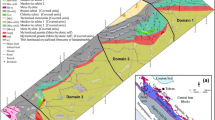Abstract
This article adopts adaptive neuro-fuzzy inference system (ANFIS) and multi adaptive regression spline (MARS) for prediction of spatial variability of reduced level of rock depth (d) in Bangalore. The database consists of 652 d values spread over a 220 km2 area of Bangalore. In two-dimensional analysis, the function \(d = f (x_{\text{1}} ,x_{\text{2}} )\), where x 1, and x 2 are the latitude and longitude of a point corresponding to d value, is to be approximated with which d value at any half space point in Bangalore can be determined. The input variables of ANFIS and MARS are x 1 and x 2. Map of d has been also produced by developed ANFIS and MARS models. The comparison between the MARS and ANFIS models demonstrates that the MARS model is superior to the ANFIS model.






Similar content being viewed by others
References
Alonso EE, Krizek RJ (1975) Stochastic formulations of soil properties. In: Proceedings of the second international conference on applications of statistics and probability in soil and structural engineering, Aachen, Germany, pp 10–32
Altrock CV (1995) Fuzzy logic and neurofuzzy applications explained. Prentice-Hall, New Jersey
Alvarez Grima M (2000) Neuro-fuzzy modeling in engineering geology. AA Balkema, Rotterdam, p 244
Asaoka A, Grivas DA (1982) Spatial variability of the undrained strength of clays. J Geotech Eng ASCE 108(5):743–745
Baecher GB (1984) On estimating auto-covariance of soil properties. Specialty conference on probabilistic mechanics and structural reliability. ASCE 110:214–218
Baker R (1984) Modeling soil variability as a random field. Math Geol 16(5):435–448
Bezdek JC (1981) Pattern recognition with fuzzy objective function algorithms. Plenum, New York, p 256
Brown M, Harris C (1994) Neurofuzzy adaptive modeling and control. Prentice-Hall, New Jersey
Caers J (2011) Modeling Uncertainty in the earth sciences. Wiley, New York
Chiasson P, Lafleur J, Soulie M, Law KT (1995) Characterizing spatial variability of clay by geostatistics. Can Geotech J 32:1–10
Craven P, Wahba G (1979) Smoothing noisy data with spline functions: estimating the correct degree of smoothing by the method of generalized cross-validation. Numer Math 31:317–403
De Veaux RD, Psichogios DC, Ungar LH (1993) A comparison of two nonparametric estimation schemes: MARS and neural networks. Comput Chem Eng 17(8):819–837
Degroot DJ (1996) Analyzing spatial variability of in situ soil properties. In: ASCE 540 proceedings of uncertainty ’96, uncertainty in the geologic environment: from theory to practice. ASCE Geotech Special Publication 58:210–238
Delhomme JP (1979) Spatial variability and uncertainty in groundwater flow parameters: a geostatistical approach. Water Resour Res 15(2):269–280
Fenton GA (1998) Random field characterization NGES data. In: Paper presented at the workshop on probabilistic site characterization at NGES, Seattle, WA, pp 550
Fenton GA (1999) Random field modeling of CPT data. J Geotech Geoenviron Eng ASCE 125(6):486–498
Friedman JH (1991) Multivariate adaptive regression splines. Ann Stat 19:1–141
Juang CH, Jiang T, Christopher RA (2001) Three-dimensional site characterization: neural network approach. Géotechnique 51(9):799–809
Kulatilake PHSW (1989) Probabilistic potentiometric surface mapping. J Geotech Eng ASCE 115(11):1569–1587
Kulatilake PHSW, Ghosh A (1998). An investigation into accuracy of spatial variation estimation using static cone penetrometer data. In: Proceedings of the first international symposium on penetration testing, Orlando. FL, USA, pp 815–821
Kulatilake PHSW, Miller KM (1987) A scheme for estimating the spatial variation of soil properties in three dimensions. In: Proceedings, first international conference on application of statistics and probability to soil and structural engineering, Vancouver, BC, Canada, pp 669–677
Lumb P (1975) Spatial variability of soil properties. In: Proceedings of the second international conference on application of statistics and probability in soil and structural engineering, Aachen, Germany, pp 397–421
Mathwork Inc (1999) Matlab user’s manual. Version 5.3. The MathWorks, Inc, Natick
Phoon KK, Kulhawy FH (1999) Characterization of geotechnical variability. Can Geotech J 36(4):612–624
Rossi ME, Deutsch CV (2014) Mineral resource estimation. Springer, Berlin
Salford systems (2001) MARSTM user guide. Salford Systems, San Diego
Sincero AP (2003) Predicting mixing power using artificial neural network. EWRI World Water and Environmental
Soulie M (1983) Geostatistical applications in geotechnics. Geostatistics for natural resources characterization, Part 2, NATO ASI Series, pp 703–615
Soulie M, Montes P, Sivestri V (1990) Modelling spatial variability of soil parameters. Can Geotech J 27:617–630
Tabba MM, Yong RN (1981) Mapping and predicting soil properties, theory. J Eng Mech ASCE 107(5):773–793
Takagi T, Sugeno M (1985) Fuzzy identification of systems and its applications to modeling and control. IEEE Trans Syst Man Cybern 15(1):116–132
Tang WH (1979) Probabilistic evaluation of penetration resistance. J Geotech Eng ASCE 105(GT10):117–191
Uzielli M, Vannucchi G, Phonn KK (2005) Random field characterisation of stress-normalised cone penetration testing parameters. Geotechnique 55(1):3–20
Vanmarcke EH (1977) Probabilistic modeling of soil profiles. J Geotech Eng ASCE 102(11):1247–1265
Vanmarcke EH (1983) Random fields: analysis and synthesis. The MIT Press, Cambridge
Wu TH, Wong K (1981) Probabilistic soil exploration: a case history. J Geotech Eng ASCE 107(GT12):1693–1711
Yaglom AM (1962) Theory of stationary random functions. Prentice-Hall, Englewood Cliffs
Yang CC, Prasher SO, Lacroix R, Kim SH (2003) A multivariate adaptive regression splines model for simulation of pesticide transport in soils. Biosyst Eng 86(1):9–15
Acknowledgments
Authors thank T.G. Sitharam for providing the rock depth data.
Author information
Authors and Affiliations
Corresponding author
Rights and permissions
About this article
Cite this article
Samui, P., Kim, D. & Viswanathan, R. Spatial variability of rock depth using adaptive neuro-fuzzy inference system (ANFIS) and multivariate adaptive regression spline (MARS). Environ Earth Sci 73, 4265–4272 (2015). https://doi.org/10.1007/s12665-014-3711-x
Received:
Accepted:
Published:
Issue Date:
DOI: https://doi.org/10.1007/s12665-014-3711-x




